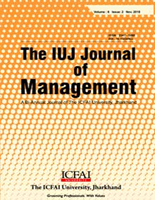( Ashok Kumar Asthana & O R S Rao )
Keywords : Aptitude, Teaching, Teachers, Colleges, Government aided, Self Financed, Institutions, Attitude, Cooperation, Optimism.




 The IUJ Journal of Management (IUJ-JOM) is the flagship journal of ICFAI University Jharkhand, Ranchi. The aim of the journal is to provide insight into the business and management research. It also creates a platform for the researchers, academicians, professors , practicing management professionals and proponents in disseminating original, theoretical and applied research in the field of management and allied disciplines.
The IUJ Journal of Management (IUJ-JOM) is the flagship journal of ICFAI University Jharkhand, Ranchi. The aim of the journal is to provide insight into the business and management research. It also creates a platform for the researchers, academicians, professors , practicing management professionals and proponents in disseminating original, theoretical and applied research in the field of management and allied disciplines.
The Journal is a Bi-Annual (November and May), double blind reviewed journal, . . . . .Read more.
 Teaching Aptitude can be defined as a condition or set of characteristics possessed by an individual, indicative of the ability to grasp not only the subject matter but also the aims and processes of education (Dave N. and Raval D., 2015). It predicts a person's ability to explain difficult points and clarify obscurities.
Teaching Aptitude can be defined as a condition or set of characteristics possessed by an individual, indicative of the ability to grasp not only the subject matter but also the aims and processes of education (Dave N. and Raval D., 2015). It predicts a person's ability to explain difficult points and clarify obscurities.
Right aptitude is the source to create competitive advantage for the organization and higher educational institutes, . . . . . .Read more.
 According to India Brand Equity Foundation (IBEF) report, in 2017 Indian advertising industry is estimated to be Rs. 63,000 Crore with both print and TV having a share of 38-40% each. With the involvement of such a huge sum of money in advertising and to get the desired effect according to the advertising objectives ,
According to India Brand Equity Foundation (IBEF) report, in 2017 Indian advertising industry is estimated to be Rs. 63,000 Crore with both print and TV having a share of 38-40% each. With the involvement of such a huge sum of money in advertising and to get the desired effect according to the advertising objectives ,
researchers/academicians and organizations are focusing highly on assessment of the effectiveness of advertisement since long. . . . . .Read more.
 The banking industry like many other financial service institutes is facing rapid regulatory, structural and technological changes in market, stiffer competition, new set of challenges, more demanding, more educated and better informed customers. The importance of both service quality and
The banking industry like many other financial service institutes is facing rapid regulatory, structural and technological changes in market, stiffer competition, new set of challenges, more demanding, more educated and better informed customers. The importance of both service quality and
customer satisfaction to service organizations in general and banking in particular has received extensive attention in recent years. . . . .Read more.
Subscribe now to get notified about IU Jharkhand journal updates!
( Ashok Kumar Asthana & O R S Rao )
Keywords : Aptitude, Teaching, Teachers, Colleges, Government aided, Self Financed, Institutions, Attitude, Cooperation, Optimism.
( Surendra Kumar & Dr. Alok Kumar Rai )
Keywords : Advertising effectiveness, Media types, Relationship matrix.
( Dr. Mamta Brahmbhatt )
Keywords : Customer services quality, Customer satisfaction, Bank service provider, Organization, Customer.
( K Satyalakshmi, Dr Pallavi Kumari & Dr. Dr Sukanya )
Keywords : Theory of applied behavior, entrepreneurial intentions, senior executives, work experience, entrepreneurship.
( Dr. Dilip Kumar & Dr. Manish Kumar )
Keywords : Handicraft, Schemes, Awareness, Government, Advertising etc.
( Sonal, Dr. Vishal Kumar & Dr. Kirti R Swain )
Keywords : Adoption, consumer adoption, mobile payment system, Ranchi, Kolkata.
( Shilpi Raj , Dr. Rajkiran Prabhakar & Mahendra Singh )
Keywords : Children, Consumer Behavior, Food choice, Consumer socialization.
( Palash Bairagi & Dr. Anindita Chakraborty )
Keywords : Risk, Risk perception, investors, Investment decision.
( Vijay Amrit Raj & Dr. Usha Kiran Rai )
Keywords : Organic Products, Socially Responsible Consumption, Consumer Attitude.
( Sushmita Singh & Prof. Raj Kumar )
Keywords : Awareness, Government interventions, Handloom industry, Satisfaction level, Outreach
( Dr. Sukanta Chandra Swain )
Keywords : Happiness, Teaching Profession, Positive aspect, Normative Aspect, HEIs, Odisha, Jharkhand
( Waseem John )
Keywords : Customer Relationship, CRM technology, Organizational incentive, Organizational Capital.
( Harsha Bhargavi Pandiri )
Keywords : Polyhouse, Rural Entrepreneurship, technology, subsidy, rural industries
( Sarosh Kothandath )
Keywords : Project Success, Project management success, Success factors, Success criteria, Performance measurement
( Himanshu Kargeti , Dr. Vikas Singh & Ms. Shilpa Wadhwa )
Keywords : Customer Attitude, M- Commerce, Higher Education Sector.
( Gayatri Nayak & S.K. Padhi )
Keywords : Working Women (WW), Household (HH), Time allocation, Occupation JEL Classification: J81, D19, J29, J24
( Dr. P K Samanta )
